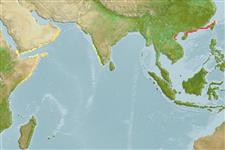>
Eupercaria/misc (Various families in series Eupercaria) >
Labridae (Wrasses) > Xyrichtyinae
Etymology: Iniistius: Latin, in = in + Greek, istion = sail; trivittatus: Named for the 3 blackish bars on the body..
More on authors: Randall & Cornish.
Environment: milieu / climate zone / depth range / distribution range
Ecologia
marino associati a barriera corallina; distribuzione batimetrica 0 - 10 m (Ref. 34279). Temperate
Northwest Pacific: known only from Hong Kong and Taiwan.
Size / Peso / Age
Maturity: Lm ? range ? - ? cm
Max length : 30.0 cm TL maschio/sesso non determinato; (Ref. 48636)
Spine dorsali (totale): 9; Raggi dorsali molli (totale): 12; Spine anali 3; Raggi anali molli: 12. Upper half of the body with 3 blackish bars; dorsal and anal fins and dorsal edge of caudal fin with pink margin; forehead with a median pale blue line. Dorsal fin incised between 2nd and 3rd spines; approximately 1/3 the length of the 2nd spine, the gap about 1.5 times larger than between 1st and 2nd or 3rd and 4th spines; dorsal spines 1st and 2nd longer than the longest dorsal soft rays. Cheek with a broad band of small scales from below eye to slightly below corner of the mouth; 2-3 scales dorsally on opercle.
Juveniles in coastal waters along reef edges on sand or rubble, or open patches on reef. Adults mainly in deep outer reef habitats where they occur in small loose group along sand ridges (Ref. 48636).
Life cycle and mating behavior
Maturità | Riproduzione | Deposizione | Uova | Fecundity | Larve
Distinct pairing during breeding (Ref. 205).
Randall, J.E. and A.S. Cornish, 2000. Xyrichtys trivittatus, a new species of razorfish (Perciformes: Labridae) from Hong Kong and Taiwan. Zool. Stud. 39(1):18-22. (Ref. 34279)
IUCN Red List Status (Ref. 130435)
Threat to humans
Harmless
Human uses
Informazioni ulteriori
Age/SizeAccrescimentoLength-weightLength-lengthLength-frequenciesMorfometriaMorfologiaLarveDinamica popolazioni larvaliReclutamentoAbbondanzaBRUVS
BibliografiaAcquacolturaProfilo di acquacolturaVarietàGeneticaElectrophoresesEreditarietàMalattieElaborazioneNutrientsMass conversion
CollaboratoriImmaginiStamps, Coins Misc.SuoniCiguateraVelocitàModalità di nuotoArea branchialeOtolithsCervelliVista
Strumenti
Special reports
Download XML
Fonti Internet
Estimates based on models
Preferred temperature (Ref.
123201): 24.2 - 28.9, mean 26.2 °C (based on 180 cells).
Phylogenetic diversity index (Ref.
82804): PD
50 = 0.5000 [Uniqueness, from 0.5 = low to 2.0 = high].
Bayesian length-weight: a=0.01023 (0.00397 - 0.02640), b=3.06 (2.84 - 3.28), in cm total length, based on LWR estimates for this (Sub)family-body shape (Ref.
93245).
Trophic level (Ref.
69278): 3.5 ±0.5 se; based on size and trophs of closest relatives
Resilienza (Ref.
120179): Medio, tempo minimo di raddoppiamento della popolazione 1.4 - 4.4 anni (Preliminary K or Fecundity.).
Fishing Vulnerability (Ref.
59153): Low vulnerability (20 of 100).
